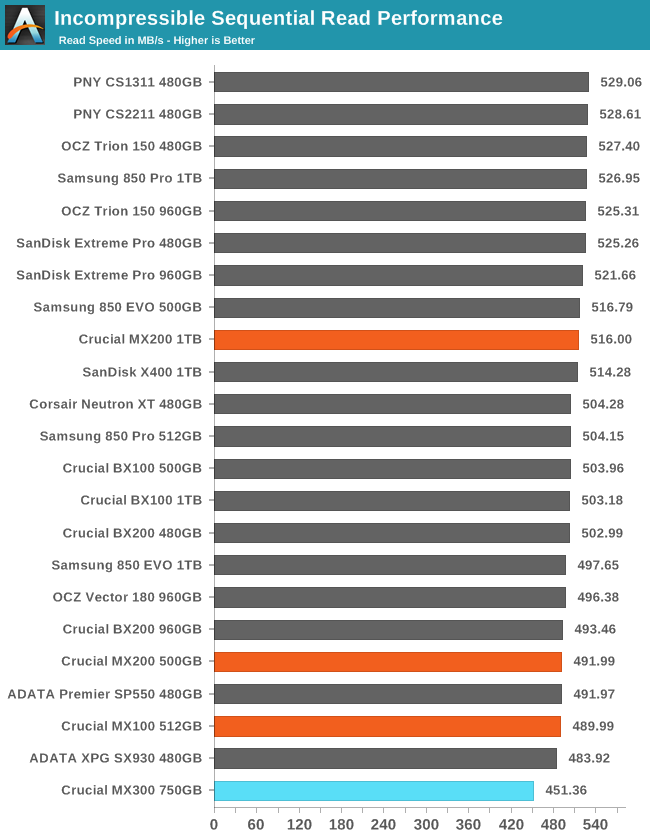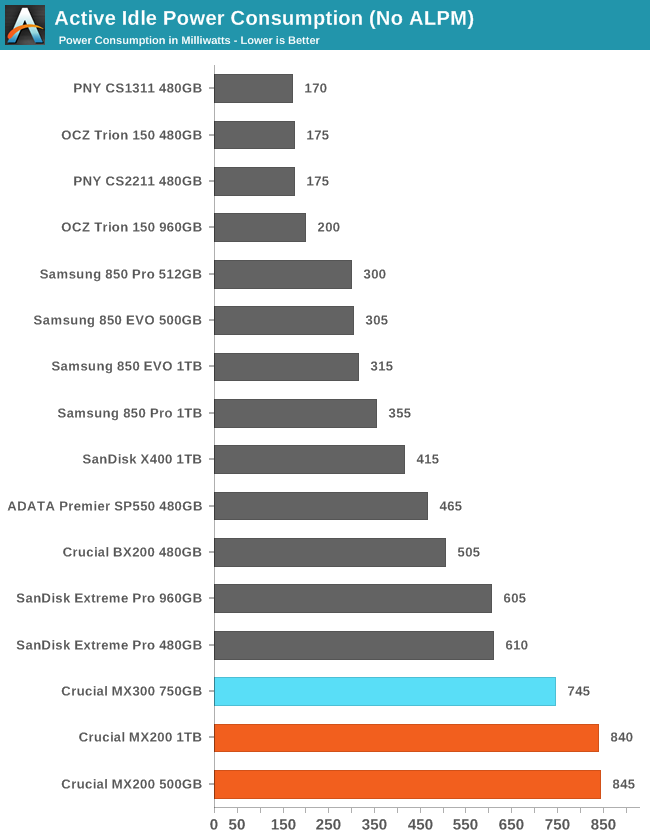The Crucial MX300 750GB SSD Review: Micron's 3D NAND Arrives
by Billy Tallis on June 14, 2016 9:00 AM ESTATTO
ATTO's Disk Benchmark is a quick and easy freeware tool to measure drive performance across various transfer sizes.
 |
|||||||||
The ATTO performance plot shows that small reads are slow but performance is reasonably stable for large transfers, albeit a little slower than the MX200.
AS-SSD
AS-SSD is another quick and free benchmark tool. It uses incompressible data for all of its tests, making it an easy way to keep an eye on which drives are relying on transparent data compression. The short duration of the test makes it a decent indicator of peak drive performance.


AS-SSD shows the MX300 read speed as suffering slightly, but the (SLC cached) write speed as perfectly normal.
Idle Power Consumption
Since the ATSB tests based on real-world usage cut idle times short to 25ms, their power consumption scores paint an inaccurate picture of the relative suitability of drives for mobile use. During real-world client use, a solid state drive will spend far more time idle than actively processing commands. Our testbed doesn't support the deepest DevSlp power saving mode that SATA drives can implement, but we can measure the power usage in the intermediate slumber state where both the host and device ends of the SATA link enter a low-power state and the drive is free to engage its internal power savings measures.
We also report the drive's idle power consumption while the SATA link is active and not in any power saving state. Drives are required to be able to wake from the slumber state in under 10 milliseconds, but that still leaves plenty of room for them to add latency to a burst of I/O. Because of this, many desktops default to either not using SATA Aggressive Link Power Management (ALPM) at all or to only enable it partially without making use of the device-initiated power management (DIPM) capability. Additionally, SATA Hot-Swap is incompatible with the use of DIPM, so our SSD testbed usually has DIPM turned off during performance testing.


Marvell's latest controller allows for great slumber power savings, but Micron needs to work on improving active idle power draw.










85 Comments
View All Comments
euskalzabe - Sunday, June 19, 2016 - link
Excellent reply, bravo.tonyman - Thursday, June 23, 2016 - link
To refute your point that "Nobody Uses SSDs for Cold Storage", I'll give a real-world counterexample... I make a machine vision system that I sell into a factory environment. I build the PCs that the system runs on, and sell it as a turnkey system. For reliability and performance, these PCs are equipped with SSDs as their boot and data drives. As this system, and therefore the PC it runs on, is mission critical, many customers purchase extra preconfigured PCs from us... which can sit around for several years before being used. Data retention on the boot drives of these cold-stored PCs is therefore quite a big issue... one I was ignorant of until a year or so ago, unfortunately. Oops.JKJK - Thursday, June 23, 2016 - link
Raid 0 for storage?Russian rulette ... catch you on the flipside.
sor - Tuesday, June 14, 2016 - link
The MX300 had best in class mixed read/write power performance, and close to the best in other power benchmarks. It seems to beat it's primary competitors (< $.30/GB) on performance, like the OCZ Trion. It could be a better value to make it an obvious buy, but it seems fair to me. It costs less and performs worse than the > $.30/gb range and costs more and performs better than the < $.25/GB.barleyguy - Tuesday, June 14, 2016 - link
"uses more power" isn't accurate. The power usage under load is flat out excellent.Byte - Tuesday, June 14, 2016 - link
Pricing average for 1TB(960GB) is about $200 (you can get ocz trion or silicon power at this price point every day, they are decent mainstream SSDs). This would need to be $150 to even be worth considering. If this had better performance maybe I can see it being worth more. I used a ton of Crucial SSDs and they are fine, but so are pretty much all the other brands i've used. I've only had 1 sandisk low end SSD die on me, and i've handled a few hundred.Gondalf - Wednesday, June 15, 2016 - link
Techreport (and Anandtech) say the contrary and i think they are a lot more reliable than you like hardware testers.TheinsanegamerN - Tuesday, June 14, 2016 - link
More power hungry, worse endurance, slower, and more expensive then the competition. Truly an amazing drive ! /sJoeyJoJo123 - Tuesday, June 14, 2016 - link
Oh no! Less SSD endurance! My current SSD gets winded after only 30 seconds of running! Whatever shall I do with typical consumer I/O workloads and less "endurance"!?[/sarcasm]kyuu - Tuesday, June 14, 2016 - link
Do people even read the article before posting negative crap anymore?It's not more power hungry. In fact, the article shows that it's quite power efficient.
I also hope you're not seriously comparing the MSRP of this drive versus the street prices of other drives. Street prices are always lower than the MSRP, especially in the SSD market.